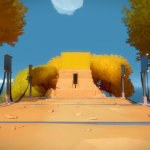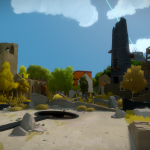Never has a game made me feel so damn clever. But on the other hand, it frequently made me feel incredibly stupid. “But of course!” I’d facepalm myself “It’s so obvious now I’ve spent twenty minutes staring at it”.

The Witness is not the game I thought it was going to be. When I heard it was about walking round a beautiful island finding puzzles to solve, I expected a variety of puzzles. I didn’t read much about the game because I wanted to discover everything myself, which I frequently do (currently on media blackout: Firewatch and No Man’s Sky) but I wish I had done in this case. Why? Because all the puzzles are the same.

Apparently there are 650-odd of them, and they’re all grid based puzzles like some sort of cerebral Painter game. As you work through them, different rules occur, like you have to collect all the dots on the lines, or make certain shapes in the grid. Later, more complex rules occur like you have to separate some grid boxes into pairs based on colour, or the route you take through the grid is based on something abstract in the world around the grid itself (like a pattern in the trees, or shadows falling on a surface). Ultimately though, every single puzzle is a grid where you have to get from the start to the finish in one single, non-overlapping line paying attention to the rules the various shapes and symbols on the grid dictate.

Solve puzzles to open doors, activate switches, enable more puzzles (this is the most frequent outcome) or ultimately, I think, fire lasers at the peak of the island’s mountain. There are 7 or 8 lasers to be found, if the locked panels each opens are to be believed, with one laser in each area of the island. I currently have three activated. These areas are home to mainly a single set of rules for the puzzles found there, with different rules in each area, with some overlap.
How you find the rules is quite clever. You’re given some very simple puzzles to begin with that are almost impossible to do incorrectly. A succession of these, with slightly increasing difficulty, teaches you what the rule is actually enforcing, without ever explicitly telling you. Sort of like how The Rosetta Stone language course works.

Some of the more abstract puzzles are incredibly clever, using the landscape and structures to make up areas you have to “pretend” are a grid. There’s one puzzle I’m especially proud of myself for solving in a sort of Japanese temple where you have to open and close shutters. It was genius, and it made me feel like a genius for getting it.
Despite my disappointment it isn’t the game I was expecting (although I’m not sure exactly what I was expecting), I’m enjoying it a great deal. I’ve found some proper head-scratchers which have caused me to leave an area and tackle a different one, and I’ve spent a large amount of time looking for “circle and a line” shapes in the shadows, rocks and even sky of the island as these are particularly pleasing to spot and activate, so even the single premise hasn’t been too repetitive. I just hope I’m not going to get stuck on a puzzle forever preventing me from finishing the game. It’s a constant worry.






